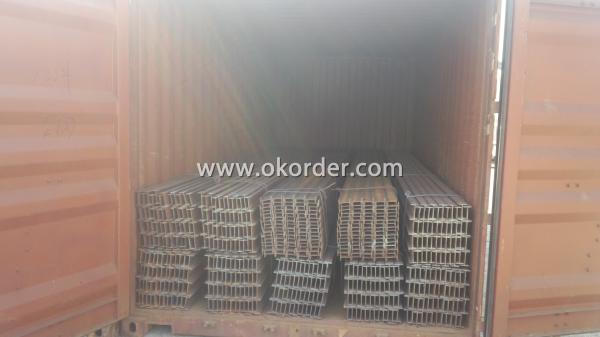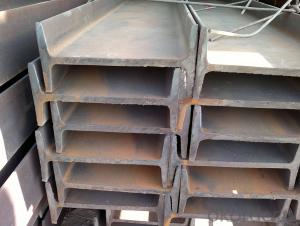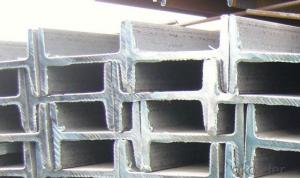Hot Rolled European Standard of I-beam
- Loading Port:
- China Main Port
- Payment Terms:
- TT or LC
- Min Order Qty:
- -
- Supply Capability:
- -
OKorder Service Pledge
OKorder Financial Service
You Might Also Like
Product Description:
OKorder is offering high quality IPEAA Beam at great prices with worldwide shipping. Our supplier is a world-class manufacturer of steel, with our products utilized the world over. OKorder annually supplies products to European, North American and Asian markets. We provide quotations within 24 hours of receiving an inquiry and guarantee competitive prices.
Product Applications:
1. structure construction and electronic tower building construction
2. bridge, trestle, autos, brackets, machinery
3.It is widely used in various building structures and engineering structures such as roof beams, bridges, transmission towers, hoisting machinery and transport machinery, ships, industrial furnaces, reaction tower, container frame and warehouse etc.
Product Advantages:
OKorder's IPEAA Beam are durable, strong, and resist corrosion.
Main Product Features:
· Premium quality
· Prompt delivery & seaworthy packing (30 days after receiving deposit)
· Corrosion resistance
· Can be recycled and reused
· Mill test certification
· Professional Service
· Competitive pricing
Product Specifications:
1.Standard: EN10025, GB Standard
Section | Standard Sectional Dimensions(mm) | ||||
| h | b | s | t | Mass Kg/m |
IPE80 | 80 | 46 | 3.80 | 5.20 | 6.00 |
IPE100 | 100 | 55 | 4.10 | 5.70 | 8.10 |
IPE120 | 120 | 64 | 4.80 | 6.30 | 10.40 |
IPE140 | 140 | 73 | 4.70 | 6.90 | 12.90 |
IPE160 | 160 | 82 | 5.00 | 7.40 | 15.80 |
IPE180 | 180 | 91 | 5.30 | 8.00 | 18.80 |
IPE200 | 200 | 100 | 5.60 | 8.50 | 22.40 |
IPE220 | 220 | 110 | 5.90 | 9.20 | 26.20 |
IPE240 | 240 | 120 | 6.20 | 9.80 | 30.70 |
IPE270 | 270 | 135 | 6.60 | 10.20 | 36.10 |
IPEAA80 | 80 | 46 | 3.20 | 4.20 | 4.95 |
IPEAA100 | 100 | 55 | 3.60 | 4.50 | 6.72 |
IPEAA120 | 120 | 64 | 3.80 | 4.80 | 8.36 |
IPEAA140 | 140 | 73 | 3.80 | 5.20 | 10.05 |
IPEAA160 | 160 | 82 | 4.00 | 5.60 | 12.31 |
IPEAA180 | 180 | 91 | 4.30 | 6.50 | 15.40 |
IPEAA200 | 200 | 100 | 4.50 | 6.70 | 17.95 |

Package & Delivery Terms of IPEAA Beam
1. Packing: it is nude packed in bundles by steel wire rod
2. Bundle weight: not more than 3.5MT for bulk vessel; less than 3 MT for container load
3. Marks:
Color marking: There will be color marking on both end of the bundle for the cargo delivered by bulk vessel. That makes it easily to distinguish at the destination port.
Tag mark: there will be tag mark tied up on the bundles. The information usually including supplier logo and name, product name, made in China, shipping marks and other information request by the customer.
If loading by container the marking is not needed, but we will prepare it as customer request.
4. All the IPEAA Beams will be delivered to the port of Tianjin within 45 days after receiving the Original L/C at sight or the advance payment by T/T.
5. Transportation: the goods are delivered by truck from mill to loading port, the maximum quantity can be loaded is around 40MTs by each truck. If the order quantity cannot reach the full truck loaded, the transportation cost per ton will be little higher than full load.

Production Flow of IPEAA Beam
Material prepare (billet) —heat up—rough rolling—precision rolling—cooling—packing—storage and transportation
FAQ:
Q1: Why buy Materials & Equipment from OKorder.com?
A1: All products offered byOKorder.com are carefully selected from China's most reliable manufacturing enterprises. Through its ISO certifications, OKorder.com adheres to the highest standards and a commitment to supply chain safety and customer satisfaction.
Q2: How do we guarantee the quality of our products?
A2: We have established an advanced quality management system which conducts strict quality tests at every step, from raw materials to the final product. At the same time, we provide extensive follow-up service assurances as required.
Q3: How soon can we receive the product after purchase?
A3: Within three days of placing an order, we will begin production. The specific shipping date is dependent upon international and government factors, but is typically 7 to 10 workdays.
- Q:How do you calculate the shear capacity of a steel I-beam?
- To calculate the shear capacity of a steel I-beam, we need to consider two main factors: the shear strength of the material and the cross-sectional properties of the beam. First, we need to determine the shear strength of the material. This can be obtained from the manufacturer's specifications or from the relevant design codes and standards. The shear strength represents the maximum stress that the material can withstand before it fails in shear. Next, we need to determine the cross-sectional properties of the I-beam. This includes the moment of inertia (I) and the area (A) of the cross-section. These properties can be calculated using the dimensions of the beam, such as the height, flange width, and web thickness. Once we have the shear strength and cross-sectional properties, we can calculate the shear capacity using the formula: Shear Capacity = Shear Strength * (A / I) This formula relates the shear strength of the material to the cross-sectional properties of the beam. By dividing the area (A) of the cross-section by the moment of inertia (I), we obtain a measure of how efficiently the material can resist shear. It is important to note that the shear capacity of a steel I-beam is also influenced by other factors, such as the presence of stiffeners or the type of connection used. These factors should also be considered in the overall design and analysis of the beam. In summary, calculating the shear capacity of a steel I-beam involves determining the shear strength of the material and using the cross-sectional properties of the beam to calculate the shear capacity using the formula Shear Capacity = Shear Strength * (A / I).
- Q:Are steel I-beams suitable for industrial buildings?
- Yes, steel I-beams are suitable for industrial buildings due to their high strength, durability, and ability to withstand heavy loads. These beams provide structural support, ensuring the stability and safety of the building, making them a popular choice in industrial construction.
- Q:Can steel I-beams be used in mezzanine or elevated platform construction?
- Yes, steel I-beams can be used in mezzanine or elevated platform construction. They provide structural support and stability, making them a common choice for such applications.
- Q:How do steel I-beams perform in terms of acoustic insulation?
- Acoustic insulation is not a strong suit for steel I-beams due to their high conductivity, enabling easy passage of sound waves. Unlike wood or concrete, steel I-beams lack the capacity to absorb or diminish sound waves. Consequently, steel I-beams are not an effective option for soundproofing or minimizing noise transmission. To achieve better acoustic insulation, alternative materials or construction methods should be explored.
- Q:What are the different types of steel coatings used on I-beams?
- I-beams commonly have different types of steel coatings that offer unique properties and benefits. Here are some of the most common types: 1. Galvanized Coating: Zinc is applied to the steel surface, providing excellent corrosion resistance and durability. It is widely used for outdoor and harsh environments. 2. Epoxy Coating: Made from epoxy resins and a curing agent, these coatings offer enhanced protection against corrosion, chemicals, abrasion, and impact. They are suitable for industrial and marine applications. 3. Powder Coating: A dry powder is applied to the I-beam surface and cured under heat to create a protective layer. It provides excellent resistance to corrosion, chemicals, and UV radiation. Customization and aesthetic appeal are possible with a wide range of color options. 4. Organic Coatings: Acrylics or urethanes can be used to protect I-beams from corrosion and provide a decorative finish. They are applied as a liquid and then cured to form a protective layer. Organic coatings offer good resistance to weathering and can be used in various environments. 5. Thermal Spray Coatings: A layer of molten or semi-molten material is applied onto the I-beam surface. These coatings can be made from metals, ceramics, and polymers, providing excellent protection against wear, corrosion, and high temperatures. Choosing the right coating for I-beams depends on the application, environmental conditions, and desired performance characteristics. Seeking advice from coating experts or engineers can help determine the most suitable coating for a specific project.
- Q:What is the cost of steel I-beams compared to other structural beams?
- The cost of steel I-beams is generally higher compared to other structural beams due to their strength, durability, and versatility in various construction applications.
- Q:How do steel I-beams perform in terms of vibration resistance?
- Steel I-beams are known for their excellent vibration resistance, making them a preferred choice in structural applications where minimizing vibrations is crucial. The inherent stiffness and rigidity of steel I-beams help to dampen and dissipate vibrations, ensuring stability and preventing excessive movement. Additionally, their high strength-to-weight ratio further enhances their ability to withstand dynamic loads and reduces the risk of resonance or vibration amplification. Thus, steel I-beams exhibit exceptional performance in terms of vibration resistance, making them reliable and dependable structural components.
- Q:How do you calculate the bearing capacity of a steel I-beam?
- In order to determine the bearing capacity of a steel I-beam, several factors should be taken into account. To begin with, one must be aware of the dimensions and properties of the I-beam, including its height, width, and thickness. These measurements are typically provided by the manufacturer or can be obtained through physical measurements. Afterwards, the material properties of the steel used in the I-beam need to be determined. This includes the yield strength, which indicates the maximum stress the material can withstand without permanent deformation, as well as the modulus of elasticity, which measures the stiffness of the material. Once these measurements and properties are obtained, various formulas and calculations can be utilized to calculate the bearing capacity of the I-beam. One commonly used calculation is Euler's buckling formula, which takes into account the compressive strength of the I-beam. Another crucial aspect to consider is the load applied to the I-beam. This load can consist of both dead loads, such as the weight of the structure it supports, and live loads, such as the weight of people or machinery. The distribution and location of the load also play a significant role in determining the bearing capacity. It is important to emphasize that expertise in structural engineering is necessary to accurately calculate the bearing capacity of a steel I-beam. It is highly recommended to consult with a professional engineer or utilize specialized software to ensure structural safety and accurately determine the bearing capacity.
- Q:Can steel I-beams be used for parking garages?
- Parking garages can indeed utilize steel I-beams. Their strength, durability, and capacity to bear loads make them a common choice in parking garage construction. They offer structural support, enabling larger spans and open areas within the garage. Moreover, steel I-beams possess resistance to fire, corrosion, and pests, making them ideal for long-term use in parking structures. Their versatility allows for different design possibilities and customization to meet specific project needs. All in all, steel I-beams are a favored option for parking garages because of their dependability and ability to withstand heavy loads.
- Q:What is a steel I-beam?
- A steel I-beam is a structural component made of steel that has the shape of the letter "I". It is commonly used in construction and engineering projects to provide strength and support in various applications such as bridges, buildings, and frameworks. The design of the I-beam distributes the load evenly across its top and bottom flanges, making it a durable and efficient choice for carrying heavy loads over long spans.
1. Manufacturer Overview |
|
|---|---|
| Location | |
| Year Established | |
| Annual Output Value | |
| Main Markets | |
| Company Certifications | |
2. Manufacturer Certificates |
|
|---|---|
| a) Certification Name | |
| Range | |
| Reference | |
| Validity Period | |
3. Manufacturer Capability |
|
|---|---|
| a)Trade Capacity | |
| Nearest Port | |
| Export Percentage | |
| No.of Employees in Trade Department | |
| Language Spoken: | |
| b)Factory Information | |
| Factory Size: | |
| No. of Production Lines | |
| Contract Manufacturing | |
| Product Price Range | |
Send your message to us
Hot Rolled European Standard of I-beam
- Loading Port:
- China Main Port
- Payment Terms:
- TT or LC
- Min Order Qty:
- -
- Supply Capability:
- -
OKorder Service Pledge
OKorder Financial Service
Similar products
New products
Hot products
Hot Searches
Related keywords






























